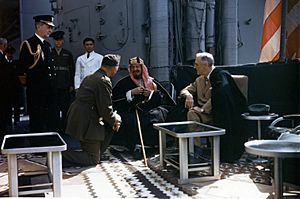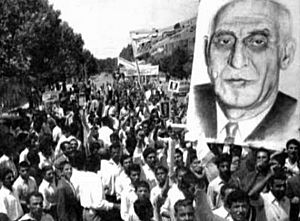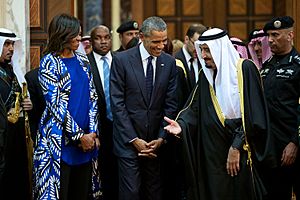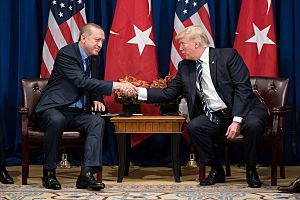United States foreign policy in the Middle East facts for kids
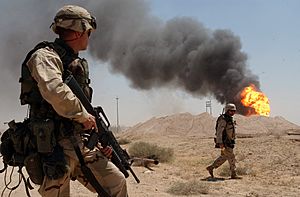
The United States foreign policy in the Middle East describes how the U.S. government deals with countries in the Middle East. This relationship began in the 1800s with the Barbary Wars. However, it became much more important after World War II.
During the Cold War, the U.S. wanted to stop the Soviet Union from gaining power in the region. So, the U.S. supported countries that were against communism. A major part of this was supporting Israel against its Arab neighbours. The U.S. also became the main protector of Saudi Arabia and other Gulf states. This was to make sure oil kept flowing from the Persian Gulf.
As of 2022, the U.S. has diplomatic ties with almost every Middle Eastern country. The only exceptions are Iran, whose relations ended in 1979 after the Islamic Revolution, and Syria, whose relations were stopped in 2012 due to the Syrian civil war. In recent years, U.S. influence in the Middle East has decreased, especially since the Arab Spring. Today, the U.S. government wants to solve the Israeli–Palestinian conflict. It also aims to stop the spread of dangerous weapons, especially in Iran.
Contents
- How U.S. involvement in the Middle East began
- The creation of Israel
- Syria: A new leader in 1949
- Iran: Mosaddeq and the Shah
- The Suez Crisis and the Eisenhower Doctrine
- Jordan and regional changes
- The Six-Day War and Black September
- Kuwait and the Gulf War
- Iran–Iraq War
- Saudi Arabia
- Afghanistan and Pakistan
- Iraq (2003–present)
- Libya (2011–present)
- Yemen
- Syria (2011–present)
- How U.S. involvement in the Middle East began
- The creation of Israel
- Syria: A new leader in 1949
- Iran: Mosaddeq and the Shah
- The Suez Crisis and the Eisenhower Doctrine
- Jordan and regional changes
- The Six-Day War and Black September
- Kuwait and the Gulf War
- Iran–Iraq War
- Saudi Arabia
- Afghanistan and Pakistan
- Iraq (2003–present)
- Libya (2011–present)
- Yemen
- Syria (2011–present)
- Turkey
- U.S. allies in the Middle East
- Countries with difficult relations with the U.S.
- Criticism of U.S. policy
- See also
How U.S. involvement in the Middle East began
The United States did not have many connections with the Middle East before World War I. However, some trade links existed in the early 1800s. President Andrew Jackson started official relations with the Sultan of Muscat and Oman in 1833. The Sultan hoped the U.S. could balance Britain's strong influence.
Trade also began between the U.S. and Persia (now Iran) in 1857. American Christian missionaries brought modern medicine and set up schools. American engineers also helped with oil projects. These connections grew before World War II. Agreements like the Red Line Agreement (1928) and the Anglo-American Petroleum Agreement (1944) showed U.S. interest in controlling Middle Eastern oil. These agreements helped major companies control oil prices worldwide.
President Franklin D. Roosevelt once told a British Ambassador in 1944:
Persian oil ... is yours. We share the oil of Iraq and Kuwait. As for Saudi Arabian oil, it's ours.
By the end of World War II, the U.S. saw the Middle East as a very important area. It was a "great material prize" because of its oil. The region was also facing big social and political changes. Many nationalistic groups were growing, which caused problems for British and French colonial powers.
Historian Jack Watson noted that European powers could not hold these lands forever due to Arab nationalism. This trend clashed with U.S. interests. These interests included stopping the Soviet Union, getting oil, and supporting a Jewish state in Palestine. These three goals later led to many U.S. actions and conflicts in the Middle East.
The creation of Israel
In 1947, the U.S. and President Truman pushed for a solution to the Arab–Israeli conflict. In May 1948, the new state of Israel was created. This process involved fighting and loss of life. The United States was the first country to officially recognize Israel. The Soviet Union and other Western nations quickly followed. However, no Arab state recognized Israel at that time.
Syria: A new leader in 1949
Syria became an independent country in 1946. But in March 1949, Army Chief of Staff Husni al-Za'im took power in a military coup. Za'im had met with U.S. CIA agents before the coup. He asked for U.S. money or help, but it is not known if he received it.
Once in power, Za'im made choices that helped the U.S. He approved the Trans-Arabian Pipeline (TAPLINE). This was an American project to move Saudi Arabian oil to ports on the Mediterranean Sea. Za'im also improved relations with Israel and Turkey, both U.S. allies. He signed a peace agreement with Israel, ending the 1948 Arab–Israeli War. He also gave up Syria's claims to Hatay Province, which was a big problem between Syria and Turkey. Za'im also cracked down on communists in Syria. However, Za'im's rule was short. He was overthrown just four and a half months later.
Iran: Mosaddeq and the Shah
Mohammad Mosaddeq became prime minister of Iran in 1951. He was a strong nationalist and did not like foreign involvement in Iran. Mosaddeq decided to nationalize Iran's oil industry. Before this, British companies like the Anglo-Iranian Oil Company made huge profits from Iranian oil. Mosaddeq also cut all diplomatic ties with Britain.
The Shah of Iran was against nationalizing the oil. He feared it would lead to an oil embargo and hurt Iran's economy. Workers in the oil industry also worried about the economic effects. Riots broke out across Iran. The Shah asked Mosaddeq to resign, but Mosaddeq refused. This led to more national uprisings. The Shah feared for his safety and left the country. He named General Fazlollah Zahedi as the new Prime Minister.
General Zahedi was a nationalist but disagreed with Mosaddeq's soft approach to the communist Tudeh party. The U.S. was also worried about the Tudeh party and the spread of Soviet influence. In late 1952, the British government asked the U.S. for help to remove Mosaddeq. President Harry S. Truman initially saw Mosaddeq as a good defense against Soviet influence. However, when Dwight D. Eisenhower became president in 1953, his administration shared Britain's concerns.
On April 4, 1953, Allen Dulles, the head of the CIA, approved one million dollars. This money was to be used "in any way that would bring about the fall of Mossadegh." After a failed attempt on August 15, Mosaddeq was overthrown on August 19, 1953. The U.S. and Britain helped General Zahedi succeed. The CIA secretly sent five million dollars to Zahedi's government on August 21, 1953. This CIA operation, called Operation Ajax, brought the Shah back to power on August 22, 1953.
The Suez Crisis and the Eisenhower Doctrine
By 1956, Egyptian leader Gamal Abdel Nasser was tired of American influence. He felt that the U.S. involvement in Egypt's affairs in exchange for aid felt like colonialism. The U.S. had stopped funding the Aswan Dam project, which angered Nasser.
The Suez Crisis in 1956 showed that British power in the Middle East was fading. The U.S. began to take its place. President Eisenhower created the Eisenhower Doctrine in response. This policy aimed to stabilize the region against Soviet threats or internal problems. It allowed the U.S. to give economic or military aid to any Middle Eastern country threatened by armed attack.
The U.S. used this doctrine to help Jordan and send troops to Lebanon to prevent a revolution. The troops in Lebanon did not fight, but it was the only time Eisenhower sent U.S. troops into a possible combat situation. Although U.S. aid helped Lebanon and Jordan, the Eisenhower Doctrine also made Nasser more popular as an Arab nationalist leader.
Jordan and regional changes
In Jordan, anti-government riots broke out. The U.S. sent Marines to nearby Lebanon, ready to help Jordan. Washington wanted to support pro-Western governments, stop Nasser's pan-Arabism, and limit Soviet influence. However, this U.S. action also caused long-term problems. It weakened Lebanon's government and angered Arab nationalists.
To keep the pro-American King Hussein of Jordan in power, the CIA sent millions of dollars in aid each year. By 1958, the U.S. faced challenges. Syria and Egypt merged into the "United Arab Republic." Anti-American revolts started in Lebanon. The pro-American King Faisal II of Iraq was overthrown by nationalist military officers. Many believed Nasser was stirring up this unrest.
The Six-Day War and Black September
In June 1967, Israel fought the Six-Day War against Egypt, Jordan, and Syria. Israel captured the West Bank, Golan Heights, and the Sinai Peninsula. The U.S. supported Israel with weapons and money throughout the 1970s.
In September 1970, Jordanian troops attacked PLO guerrilla camps. The U.S. and Israel helped Jordan. Jordan's U.S.-supplied air force dropped napalm. The U.S. also sent an aircraft carrier and destroyers near Lebanon. They prepared troops in Turkey to support the attack. These U.S. actions before the Iranian revolution were influenced by economic reasons and the Cold War.
Kuwait and the Gulf War
The Gulf War happened in 1991. A group of 35 countries, led by the United States, fought against Iraq. Iraq had invaded Kuwait. Iraq had been an ally of the Soviet Union, so it had few ties with the U.S. When Iraq threatened Kuwait, the U.S. said it would protect its allies.
After the invasion in 1990, the U.S. asked the United Nations Security Council for a meeting. They passed Resolution 660, which put economic penalties on Iraq. The U.S. rejected Iraq's offer to leave Kuwait if a solution for Palestine was found. In 1991, the U.S. used military force, as allowed by Resolution 678. The U.S. led the coalition, with 73% of the armed forces being American. U.S. forces led many air strikes and land battles against the Iraqi army.
Iran–Iraq War
On September 22, 1980, Saddam Hussein's Iraq attacked Ayatollah Khomeini's Iran. This started the Iran–Iraq War. Iraq bombed 10 military airfields.
U.S. support for Iraq
In July 1992, an ABC News report showed U.S. cooperation with Iraq. The U.S. sent money, weapons, and technology to Iraq. They also had emergency plans against Iran. According to CIA files, the U.S. knew Iraq was using chemical weapons. This went against the Geneva Protocol of 1925. The U.S. Defense Intelligence Agency even gave Iraq satellite information on Iranian troops. This helped Iraq track its enemies.
The U.S. secretly supported Iraq in the war. Some scholars say the U.S. gave a "green light" for Hussein to attack Iran. However, new U.S. and Iraqi papers suggest this is "more a myth than reality." The U.S. did not encourage the war, and Hussein's attack was his own decision.
U.S. support for Iran
U.S.-Iran relations changed a lot after the 1979 Iranian Revolution. This event saw the fall of the Shah, who was close to the Western world. Ayatollah Khomeini took over, bringing back Islamic law. In 1979, protesters took over the U.S. Embassy in Tehran, holding American civilians hostage.
In 1980, the U.S. changed its policy. It allowed Israel to sell American weapons to Iran during the war. This deal was set up by Robert McFarlane and agreed upon by U.S. Secretary of State Alexander Haig and Israeli Prime Minister Menachem Begin. The weapons were supposed to be supplied for 6 to 18 months. This support was first explained as a way to get the American hostages back. However, the hostages were released before the U.S. supplied weapons. Also, the weapons supply lasted longer than planned. This became known as the Iran–Contra affair in November 1985. The U.S. supplied weapons to Iran through Israel. The money from these sales went to fund the Contra rebels in Nicaragua. These rebels were fighting against the Sandinista government.
Saudi Arabia
Saudi Arabia and the United States are important allies. However, relations became tense after the September 11 attacks. U.S. foreign policy in Saudi Arabia began with the Pact of Quincy in 1945. This agreement meant the U.S. would protect the Saudi royal family. In return, Saudi Arabia would provide oil to the U.S. The U.S. also gave military aid during the Gulf War, sending almost 500,000 soldiers to protect Saudi Arabia from Iraq. These events made the Saudi family rely on U.S. protection.
In March 2015, President Barack Obama allowed U.S. forces to help Saudi Arabia in its military actions in Yemen. They set up a "Joint Planning Cell" with Saudi Arabia. A report by Human Rights Watch said that U.S.-made bombs were used in attacks that harmed civilians. These attacks violated the rules of war.
U.S.-Saudi Arabia arms deal
Both countries want to fight terrorism and are allies. In 2017, President Donald Trump announced a deal to provide Saudi Arabia with $115 billion worth of weapons. This included tanks, combat ships, and missile defense systems. By 2018, the Saudi government had bought over $14.5 billion in weapons from the U.S.
Also in 2018, the Saudi-led group fighting in Yemen bombed a school bus, killing 40 children. The bomb was provided by the United States. Many people criticized the U.S. for supporting Saudi Arabia's actions in Yemen. This support contributed to the deaths of 10,000 children. In December 2018, senators voted to end American help for Saudi Arabia's war in Yemen. The U.S. not fully supporting the Saudi-led actions in Yemen strained the relationship. This led Saudi Arabia to refuse the U.S. request to increase oil production.
Afghanistan and Pakistan
Afghanistan and Pakistan are in South Asia but are often considered part of the Greater Middle East. U.S. involvement in both countries began with the Carter Administration after the Soviet invasion of Afghanistan.
The U.S. relationship with Afghanistan and Pakistan has been closely linked to the War on Terrorism. American policy has helped coordinate conflicts in Afghanistan and northwestern Pakistan. Recently, the political situations of both countries have been grouped under one term: "AfPak."
Iraq (2003–present)
The U.S. led an invasion of Iraq in 2003. This started the Iraq War. U.S. troops remained in Iraq for many years. The U.S. also led an intervention in Iraq starting in 2014.
Libya (2011–present)
The U.S. was involved in the First Libyan Civil War in 2011. This included a military intervention. The U.S. has also been involved in the Second Libyan Civil War.
Yemen
20th century relations
The U.S. started diplomatic relations with Yemen in 1947 when Yemen joined the United Nations. The U.S. recognized the Yemen Arab Republic in 1962 and the People's Democratic Republic of Yemen in 1967. In the 20th century, U.S. policies in Yemen supported unification. They focused mainly on humanitarian aid and some military operations. In the 1990s, the U.S. started a $42 million program in Yemen. This program helped with agriculture, education, and health. In return, the Yemeni government worked with U.S. oil companies. However, the U.S.-Yemen relationship worsened when they took different sides during the Kuwait crisis.
21st century relations
Al-Qaeda's terrorist attacks in the United States changed U.S. policies in Yemen. The U.S. has taken many military actions against the terrorist group. It also provides humanitarian help and works with other groups. The Yemeni government improved its cooperation with the U.S. in fighting terrorism after these events.
- Humanitarian aid
Over the past decades, the U.S. has responded to Yemen's humanitarian crisis. This crisis was caused by the war. U.S. funding for Yemen has increased from $115 million in 2012 to almost a billion dollars in 2019. This money helps with food, health, education, and protection. However, the Saudi-led group, supported by the U.S., has blocked access to the country. This prevents humanitarian aid from fully reaching those who need it.
- Military actions
Military policies in Yemen have increased since Abdrabbuh Mansur Hadi replaced President Ali Abdullah Saleh. Hadi was much more willing to fight terrorism in Yemen. U.S. military policies include training the Yemeni military, supplying weapons, and conducting air strikes. The U.S. also made an agreement with Saudi Arabia in 2015. This agreement means the U.S. supplies weapons to Saudi Arabia for anti-terrorism actions in Yemen.
Syria (2011–present)
In 2011, many anti-government protests began in Arab countries. This period is known as the Arab Spring. In Syria, protests against the Assad government were put down, leading to a civil war.
U.S. involvement in the Syrian civil war began under President Obama in 2015. U.S. troops continued to be involved under President Trump. Trump often said he wanted to remove troops from Syria, but this never fully happened. The U.S. continued to lead an alliance of up to 74 countries. Their goal was to fight the Islamic State of Iraq and Read more about the U.S. foreign policy in the Middle East in this article.

The United States foreign policy in the Middle East describes how the U.S. government deals with countries in the Middle East. This relationship began in the 1800s with the Barbary Wars. However, it became much more important after World War II.
During the Cold War, the U.S. wanted to stop the Soviet Union from gaining power in the region. So, the U.S. supported countries that were against communism. A major part of this was supporting Israel against its Arab neighbours. The U.S. also became the main protector of Saudi Arabia and other Gulf states. This was to make sure oil kept flowing from the Persian Gulf.
As of 2022, the U.S. has diplomatic ties with almost every Middle Eastern country. The only exceptions are Iran, whose relations ended in 1979 after the Islamic Revolution, and Syria, whose relations were stopped in 2012 due to the Syrian civil war. In recent years, U.S. influence in the Middle East has decreased, especially since the Arab Spring. Today, the U.S. government wants to solve the Israeli–Palestinian conflict. It also aims to stop the spread of dangerous weapons, especially in Iran.
How U.S. involvement in the Middle East began
The United States did not have many connections with the Middle East before World War I. However, some trade links existed in the early 1800s. President Andrew Jackson started official relations with the Sultan of Muscat and Oman in 1833. The Sultan hoped the U.S. could balance Britain's strong influence.
Trade also began between the U.S. and Persia (now Iran) in 1857. American Christian missionaries brought modern medicine and set up schools. American engineers also helped with oil projects. These connections grew before World War II. Agreements like the Red Line Agreement (1928) and the Anglo-American Petroleum Agreement (1944) showed U.S. interest in controlling Middle Eastern oil. These agreements helped major companies control oil prices worldwide.
President Franklin D. Roosevelt once told a British Ambassador in 1944:
Persian oil ... is yours. We share the oil of Iraq and Kuwait. As for Saudi Arabian oil, it's ours.
By the end of World War II, the U.S. saw the Middle East as a very important area. It was a "great material prize" because of its oil. The region was also facing big social and political changes. Many nationalistic groups were growing, which caused problems for British and French colonial powers.
Historian Jack Watson noted that European powers could not hold these lands forever due to Arab nationalism. This trend clashed with U.S. interests. These interests included stopping the Soviet Union, getting oil, and supporting a Jewish state in Palestine. These three goals later led to many U.S. actions and conflicts in the Middle East.
The creation of Israel
In 1947, the U.S. and President Truman pushed for a solution to the Arab–Israeli conflict. In May 1948, the new state of Israel was created. This process involved fighting and loss of life. The United States was the first country to officially recognize Israel. The Soviet Union and other Western nations quickly followed. However, no Arab state recognized Israel at that time.
Syria: A new leader in 1949
Syria became an independent country in 1946. But in March 1949, Army Chief of Staff Husni al-Za'im took power in a military coup. Za'im had met with U.S. CIA agents before the coup. He asked for U.S. money or help, but it is not known if he received it.
Once in power, Za'im made choices that helped the U.S. He approved the Trans-Arabian Pipeline (TAPLINE). This was an American project to move Saudi Arabian oil to ports on the Mediterranean Sea. Za'im also improved relations with Israel and Turkey, both U.S. allies. He signed a peace agreement with Israel, ending the 1948 Arab–Israeli War. He also gave up Syria's claims to Hatay Province, which was a big problem between Syria and Turkey. Za'im also cracked down on communists in Syria. However, Za'im's rule was short. He was overthrown just four and a half months later.
Iran: Mosaddeq and the Shah
Mohammad Mosaddeq became prime minister of Iran in 1951. He was a strong nationalist and did not like foreign involvement in Iran. Mosaddeq decided to nationalize Iran's oil industry. Before this, British companies like the Anglo-Iranian Oil Company made huge profits from Iranian oil. Mosaddeq also cut all diplomatic ties with Britain.
The Shah of Iran was against nationalizing the oil. He feared it would lead to an oil embargo and hurt Iran's economy. Workers in the oil industry also worried about the economic effects. Riots broke out across Iran. The Shah asked Mosaddeq to resign, but Mosaddeq refused. This led to more national uprisings. The Shah feared for his safety and left the country. He named General Fazlollah Zahedi as the new Prime Minister.
General Zahedi was a nationalist but disagreed with Mosaddeq's soft approach to the communist Tudeh party. The U.S. was also worried about the Tudeh party and the spread of Soviet influence. In late 1952, the British government asked the U.S. for help to remove Mosaddeq. President Harry S. Truman initially saw Mosaddeq as a good defense against Soviet influence. However, when Dwight D. Eisenhower became president in 1953, his administration shared Britain's concerns.
On April 4, 1953, Allen Dulles, the head of the CIA, approved one million dollars. This money was to be used "in any way that would bring about the fall of Mossadegh." After a failed attempt on August 15, Mosaddeq was overthrown on August 19, 1953. The U.S. and Britain helped General Zahedi succeed. The CIA secretly sent five million dollars to Zahedi's government on August 21, 1953. This CIA operation, called Operation Ajax, brought the Shah back to power on August 22, 1953.
The Suez Crisis and the Eisenhower Doctrine
By 1956, Egyptian leader Gamal Abdel Nasser was tired of American influence. He felt that the U.S. involvement in Egypt's affairs in exchange for aid felt like colonialism. The U.S. had stopped funding the Aswan Dam project, which angered Nasser.
The Suez Crisis in 1956 showed that British power in the Middle East was fading. The U.S. began to take its place. President Eisenhower created the Eisenhower Doctrine in response. This policy aimed to stabilize the region against Soviet threats or internal problems. It allowed the U.S. to give economic or military aid to any Middle Eastern country threatened by armed attack.
The U.S. used this doctrine to help Jordan and send troops to Lebanon to prevent a revolution. The troops in Lebanon did not fight, but it was the only time Eisenhower sent U.S. troops into a possible combat situation. Although U.S. aid helped Lebanon and Jordan, the Eisenhower Doctrine also made Nasser more popular as an Arab nationalist leader.
Jordan and regional changes
In Jordan, anti-government riots broke out. The U.S. sent Marines to nearby Lebanon, ready to help Jordan. Washington wanted to support pro-Western governments, stop Nasser's pan-Arabism, and limit Soviet influence. However, this U.S. action also caused long-term problems. It weakened Lebanon's government and angered Arab nationalists.
To keep the pro-American King Hussein of Jordan in power, the CIA sent millions of dollars in aid each year. By 1958, the U.S. faced challenges. Syria and Egypt merged into the "United Arab Republic." Anti-American revolts started in Lebanon. The pro-American King Faisal II of Iraq was overthrown by nationalist military officers. Many believed Nasser was stirring up this unrest.
The Six-Day War and Black September
In June 1967, Israel fought the Six-Day War against Egypt, Jordan, and Syria. Israel captured the West Bank, Golan Heights, and the Sinai Peninsula. The U.S. supported Israel with weapons and money throughout the 1970s.
In September 1970, Jordanian troops attacked PLO guerrilla camps. The U.S. and Israel helped Jordan. Jordan's U.S.-supplied air force dropped napalm. The U.S. also sent an aircraft carrier and destroyers near Lebanon. They prepared troops in Turkey to support the attack. These U.S. actions before the Iranian revolution were influenced by economic reasons and the Cold War.
Kuwait and the Gulf War
The Gulf War happened in 1991. A group of 35 countries, led by the United States, fought against Iraq. Iraq had invaded Kuwait. Iraq had been an ally of the Soviet Union, so it had few ties with the U.S. When Iraq threatened Kuwait, the U.S. said it would protect its allies.
After the invasion in 1990, the U.S. asked the United Nations Security Council for a meeting. They passed Resolution 660, which put economic penalties on Iraq. The U.S. rejected Iraq's offer to leave Kuwait if a solution for Palestine was found. In 1991, the U.S. used military force, as allowed by Resolution 678. The U.S. led the coalition, with 73% of the armed forces being American. U.S. forces led many air strikes and land battles against the Iraqi army.
Iran–Iraq War
On September 22, 1980, Saddam Hussein's Iraq attacked Ayatollah Khomeini's Iran. This started the Iran–Iraq War. Iraq bombed 10 military airfields.
U.S. support for Iraq
In July 1992, an ABC News report showed U.S. cooperation with Iraq. The U.S. sent money, weapons, and technology to Iraq. They also had emergency plans against Iran. According to CIA files, the U.S. knew Iraq was using chemical weapons. This went against the Geneva Protocol of 1925. The U.S. Defense Intelligence Agency even gave Iraq satellite information on Iranian troops. This helped Iraq track its enemies.
The U.S. secretly supported Iraq in the war. Some scholars say the U.S. gave a "green light" for Hussein to attack Iran. However, new U.S. and Iraqi papers suggest this is "more a myth than reality." The U.S. did not encourage the war, and Hussein's attack was his own decision.
U.S. support for Iran
U.S.-Iran relations changed a lot after the 1979 Iranian Revolution. This event saw the fall of the Shah, who was close to the Western world. Ayatollah Khomeini took over, bringing back Islamic law. In 1979, protesters took over the U.S. Embassy in Tehran, holding American civilians hostage.
In 1980, the U.S. changed its policy. It allowed Israel to sell American weapons to Iran during the war. This deal was set up by Robert McFarlane and agreed upon by U.S. Secretary of State Alexander Haig and Israeli Prime Minister Menachem Begin. The weapons were supposed to be supplied for 6 to 18 months. This support was first explained as a way to get the American hostages back. However, the hostages were released before the U.S. supplied weapons. Also, the weapons supply lasted longer than planned. This became known as the Iran–Contra affair in November 1985. The U.S. supplied weapons to Iran through Israel. The money from these sales went to fund the Contra rebels in Nicaragua. These rebels were fighting against the Sandinista government.
Saudi Arabia
Saudi Arabia and the United States are important allies. However, relations became tense after the September 11 attacks. U.S. foreign policy in Saudi Arabia began with the Pact of Quincy in 1945. This agreement meant the U.S. would protect the Saudi royal family. In return, Saudi Arabia would provide oil to the U.S. The U.S. also gave military aid during the Gulf War, sending almost 500,000 soldiers to protect Saudi Arabia from Iraq. These events made the Saudi family rely on U.S. protection.
In March 2015, President Barack Obama allowed U.S. forces to help Saudi Arabia in its military actions in Yemen. They set up a "Joint Planning Cell" with Saudi Arabia. A report by Human Rights Watch said that U.S.-made bombs were used in attacks that harmed civilians. These attacks violated the rules of war.
U.S.-Saudi Arabia arms deal
Both countries want to fight terrorism and are allies. In 2017, President Donald Trump announced a deal to provide Saudi Arabia with $115 billion worth of weapons. This included tanks, combat ships, and missile defense systems. By 2018, the Saudi government had bought over $14.5 billion in weapons from the U.S.
Also in 2018, the Saudi-led group fighting in Yemen bombed a school bus, killing 40 children. The bomb was provided by the United States. Many people criticized the U.S. for supporting Saudi Arabia's actions in Yemen. This support contributed to the deaths of 10,000 children. In December 2018, senators voted to end American help for Saudi Arabia's war in Yemen. The U.S. not fully supporting the Saudi-led actions in Yemen strained the relationship. This led Saudi Arabia to refuse the U.S. request to increase oil production.
Afghanistan and Pakistan
Afghanistan and Pakistan are in South Asia but are often considered part of the Greater Middle East. U.S. involvement in both countries began with the Carter Administration after the Soviet invasion of Afghanistan.
The U.S. relationship with Afghanistan and Pakistan has been closely linked to the War on Terrorism. American policy has helped coordinate conflicts in Afghanistan and northwestern Pakistan. Recently, the political situations of both countries have been grouped under one term: "AfPak."
Iraq (2003–present)
The U.S. led an invasion of Iraq in 2003. This started the Iraq War. U.S. troops remained in Iraq for many years. The U.S. also led an intervention in Iraq starting in 2014.
Libya (2011–present)
The U.S. was involved in the First Libyan Civil War in 2011. This included a military intervention. The U.S. has also been involved in the Second Libyan Civil War.
Yemen
20th century relations
The U.S. started diplomatic relations with Yemen in 1947 when Yemen joined the United Nations. The U.S. recognized the Yemen Arab Republic in 1962 and the People's Democratic Republic of Yemen in 1967. In the 20th century, U.S. policies in Yemen supported unification. They focused mainly on humanitarian aid and some military operations. In the 1990s, the U.S. started a $42 million program in Yemen. This program helped with agriculture, education, and health. In return, the Yemeni government worked with U.S. oil companies. However, the U.S.-Yemen relationship worsened when they took different sides during the Kuwait crisis.
21st century relations
Al-Qaeda's terrorist attacks in the United States changed U.S. policies in Yemen. The U.S. has taken many military actions against the terrorist group. It also provides humanitarian help and works with other groups. The Yemeni government improved its cooperation with the U.S. in fighting terrorism after these events.
- Humanitarian aid
Over the past decades, the U.S. has responded to Yemen's humanitarian crisis. This crisis was caused by the war. U.S. funding for Yemen has increased from $115 million in 2012 to almost a billion dollars in 2019. This money helps with food, health, education, and protection. However, the Saudi-led group, supported by the U.S., has blocked access to the country. This prevents humanitarian aid from fully reaching those who need it.
- Military actions
Military policies in Yemen have increased since Abdrabbuh Mansur Hadi replaced President Ali Abdullah Saleh. Hadi was much more willing to fight terrorism in Yemen. U.S. military policies include training the Yemeni military, supplying weapons, and conducting air strikes. The U.S. also made an agreement with Saudi Arabia in 2015. This agreement means the U.S. supplies weapons to Saudi Arabia for anti-terrorism actions in Yemen.
Syria (2011–present)
In 2011, many anti-government protests began in Arab countries. This period is known as the Arab Spring. In Syria, protests against the Assad government were put down, leading to a civil war.
U.S. involvement in the Syrian civil war began under President Obama in 2015. U.S. troops continued to be involved under President Trump. Trump often said he wanted to remove troops from Syria, but this never fully happened. The U.S. continued to lead an alliance of up to 74 countries. Their goal was to fight the ISIS terrorist group. They also had peacekeeping and oilfield patrolling missions.
The situation became more complex in 2019. Turkey made a deal with Russia, whose army also got involved. The U.S. and its allies fought in many battles. They mostly supported the Kurdish-led YPG and SDF liberation army. This caused tension with Turkey, which continued to fight Kurds in Syria. The U.S. military presence in Syria continues under President Biden. The focus of military operations and airstrikes has shifted to the East. This is to better fight militias supported by Iran.
Turkey
Coup attempt (2016)
On July 15, 2016, a coup d'état was attempted in Turkey. A group within the Turkish Armed Forces tried to take control from the government and President Recep Tayyip Erdoğan.
The Turkish government accused the coup leaders of being linked to the Gülen movement. This group is considered a terrorist organization by Turkey. It is led by Fethullah Gülen, a Turkish cleric who lives in Pennsylvania, United States. Erdoğan claims Gülen was behind the coup, but Gülen denies this. Erdoğan also accused the United States of protecting Gülen. President Erdoğan also accused General Joseph Votel, head of United States Central Command, of "siding with coup plotters." This happened after Votel said the Turkish government was arresting the Pentagon's contacts in Turkey.
U.S. allies in the Middle East
- Countries
 Israel (Major non-NATO ally)
Israel (Major non-NATO ally)
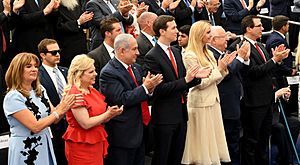 Dedication ceremony of the U.S. Embassy in Jerusalem, Israel, May 14, 2018
Dedication ceremony of the U.S. Embassy in Jerusalem, Israel, May 14, 2018 Saudi Arabia
Saudi Arabia Imperial State of Iran (before 1979)
Imperial State of Iran (before 1979) Turkey
Turkey Qatar (Major non-NATO ally)
Qatar (Major non-NATO ally) Bahrain (Major non-NATO ally)
Bahrain (Major non-NATO ally) Kuwait (Major non-NATO ally)
Kuwait (Major non-NATO ally) United Arab Emirates
United Arab Emirates Jordan (Major non-NATO ally)
Jordan (Major non-NATO ally) Egypt (Major non-NATO ally)
Egypt (Major non-NATO ally) Cyprus
Cyprus
- Regions
- Groups
 People's Mujahedin of Iran
People's Mujahedin of Iran
 National Council of Resistance of Iran
National Council of Resistance of Iran
 Pahlavi Royal Family (led by Reza Pahlavi)
Pahlavi Royal Family (led by Reza Pahlavi)- Syrian Democratic Forces
 Free Syrian Army
Free Syrian Army
Countries with difficult relations with the U.S.
- Countries
 Islamic Republic of Iran
Islamic Republic of Iran Syria
Syria Turkey (Even though Turkey is a NATO member, relations have become difficult.)
Turkey (Even though Turkey is a NATO member, relations have become difficult.)
- Groups
 Islamic Revolutionary Guard Corps
Islamic Revolutionary Guard CorpsHezbollah
- Popular Mobilization Forces
 Houthi movement
Houthi movement
Criticism of U.S. policy
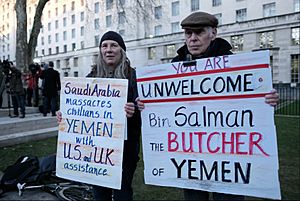
The United States foreign policy in the Middle East has faced criticism. For example, many have criticized U.S. involvement in the conflict in Yemen.
See also
 In Spanish: Política exterior de Estados Unidos en Medio Oriente para niños
In Spanish: Política exterior de Estados Unidos en Medio Oriente para niños


